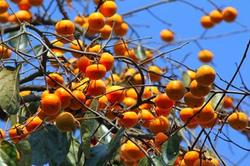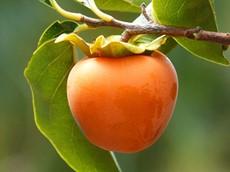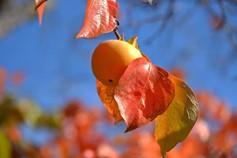Persimmons: Not So Persnickety

And besides, how could a fruit tree possibly be bad whose botanical name, Diospyros, means “fruit of the Gods”?
Year-round beauty
Persimmon trees offer distinctive year-round pleasure, making them excellent additions to the home landscape.
- In spring, new growth sprouts quickly and consistently. Persimmon flowers are inconspicuous, usually appearing in groups of one to five per twig as the new growth appears, typically through March. The flowers are small, bell-shaped, and white to limey-green-yellow. Although the flowers aren't showy, the calyx grows to be quite prominent on the developing fruit.
- In summer, persimmon leaves are lush, large, and leathery, with bright green tops and soft green bottoms that give them a two-tone effect. The leaves grow up to 4-inches wide and 7-inches long, providing deep, welcomed shade and an almost tropical appearance.
- In autumn, persimmon put on a dramatically colorful show, with leaves turning brilliant crimson, orange, and yellow.
- In winter, persimmon trees may be at their most beautiful. Branches are laid bare but the fruit remains hanging like ornaments.
Healthy, tasty, and useful
Persimmons are a healthy addition to any diet, boasting a high potassium content and more fiber, minerals, and phenolic compounds than an apple. They also support many species of birds. And the next time you’re out on the golf course, remember that the wood you’re swinging is most likely persimmon. Ditto the fancy inlay work on your jewelry box.
You may also be surprised by the number of cake, cookie, ice cream, bread, and pie recipes in which to use your prized and usually prolific fruit as a healthy and unique sugar alternative. Then again, if cooking with persimmons isn’t your thing, you can simply display them in a decorative bowl indoors where they make beautiful, colorful autumnal displays.
Squishy or firm fruit: take your pick
The two main varieties in our area are Hachiya and Fuyu.

Hachiya persimmons are large, acorn-shaped fruits. Because they are jam-packed with tannin, they cannot be eaten until fully ripe, either on the tree or indoors after harvesting. Otherwise, they are extremely astringent. Fully ripe means waiting until they are mushy, bright orange, and gelatinous inside. As Pocahontas’s Captain John Smith reported back to the English, “ If it not be ripe it will draw a man’s mouth awry with much torment. But when it is ripe, it is as delicious as an apricot.” Photo: Piqsels

Fuyu persimmons are firmer, squat-shaped fruit that may be eaten fresh off the tree. These fruits resemble smooth mini-pumpkins, flat and squat. Whether eaten whole like an apple or sliced fresh in salads, Fuyu persimmons add a pleasant, flavorful crunch. These persimmons do not contain high levels of tannin, so they can be eaten hard or soft. Photo: Piqsels
How to grow persimmons
Marin's temperate climate is perfect for these trees. Persimmon trees have a low chilling requirement (less than 100 hours), so they are reliable fruiters. They are not picky about soil and require little fertilizer. Persimmons are also somewhat drought tolerant, although the fruit will be larger and tastier with regular irrigation. Like all fruit trees, they require regular irrigation in the early years to become established. Should the weather serve up a period of extreme heat even an established tree will appreciate additional water.
Persimmons do not need a companion tree for pollination as they are self-fruitful. Having just one tree is fine and even desirable as the tree can grow quite large – up to 25-feet tall and wide. Adequate space is necessary for size and air circulation. As with most fruit trees, full sun and good drainage is ideal. Prune when young to remove suckers and establish a good framework. Mature trees require little pruning.
Here are detailed growing instructions for growing persimmon trees.
Plant bare root in winter
The best time of year for planting is December to January. Look for bare root stock with a trunk of about half-inch in diameter acquired from a quality nursery for your best chance at success. Here's how to plant a bare root tree.
Pests and diseases
Persimmon trees are relatively pest and disease free, although squirrels, deer, coyotes, rats, opossums, and birds are fond of the fruit and gophers will go after the roots. Nice if you want wildlife. Not nice if you want persimmon bread. If you don’t want to duke it out with these feathery, furry friends, consider picking fruit before it's ripe and ripen it indoors instead. This leaves less perfect produce for our wildlife friends. Winners all around! As a safeguard against underground attacks, use gopher baskets when planting.
